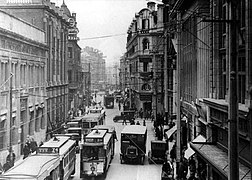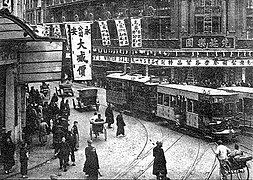Trams in Shanghai (1908–1975)
|
Part of a series on |
|
Long Distance |
|---|
|
|
|
|
|
|
|
Trams in Shanghai |
|
|
|
|
First generation trams in Shanghai began operating in 1908 using a steel wheeled
In 2010, the
Initial sections
The first proposal for a tram network in Shanghai was in 1881; Jardine Matheson proposed to the French Concession Board of Directors the opening of tram services in the French Concession, and both parties began planning for a tram network. The Board of Directors adopted the initiative and began planning a tram network.[2]
The first tram line in Shanghai (China’s first tram appeared in Beijing in 1899), Yingshang No. 1, opened on January 21, 1908, and operated between
On November 14, 1914, Shanghai was the first city in China to use trolleybuses in the former French Concession.
-
The first tram in Shanghai (1908)
-
Trams on Jiujiang Road in the 1920s
-
A tram in the 'British system' in the 1920s
Three tramway systems
Three tram companies expanded their routes step by step, and collectively reached their maximum extent in 1925 with 328 tramcars and 14 routes. By the 1920s, trams carried supplementary letters to their numbers: 'B' for British and 'F' for French.
- The British system ("Shanghai Tramways"; The Shanghai Electric Construction Co. Ltd.) was the largest with seven routes and 216 trams;
- The French system ("La Compagnie Francaise de Tramways et d'Eclairage Electrique de Changhai") had three routes and 60 trams;
- The Chinese system ("Chinese Tramways Company"; Chinese Electric Power Co. Ltd.) had four routes and 52 trams, totaling 23.5 km in length.[6]
-
1903 map showing the built and planned tram routes in the French concession
-
1936 Shanghai tram map on recent street map
-
1936 Shanghai tram map
-
1937 Shanghai tram map with all three systems
-
1939 tram map of the Shanghai International Settlement, showing disrupted routes
During the Japanese occupation of Shanghai in
During the
Technology
Tramways ran on
On the British tramways, traditional four-wheel single-deck cars built by the Brush Electrical Engineering Company Limited in their Falcon Works at Loughborough, England were utilized. These trams were similar to the trams of London's Metropolitan Electric Tramways that were used for their Alexandra Palace line.
See also
- List of tram and light rail transit systems
- Hong Kong tram
- Changchun Tram
- Dalian tram
- TEDA Modern Guided Rail Tram (rubber tired tram of Tianjin)
- Shanghai Metro
- Trolleybuses in Shanghai
Current operating tram systems in Shanghai:
- The rubber tired tram opened in Zhangjiang Hi-tech Park in 2010.
- The Songjiang Tram opened in late 2018.
References
- ^ Zhang, Hai 张海 (March 31, 2008). 旧上海的轨道交通 [Rail Transit in Old Shanghai]. 上海档案信息网 (in Chinese). Archived from the original on January 22, 2022. Retrieved March 31, 2008.
- ^ 专业志 >> 上海档案志 >> 第二编租界档案 >> 第一章档案种类 >> 节. 上海市地方志办公室 (in Chinese). Archived from the original on March 5, 2016. Retrieved September 10, 2017.
- ^ a b 上海通志 >> 第二十六卷城市建设 >> 第三章公共交通 >> 节. 上海市地方志办公室 (in Chinese). Archived from the original on December 2, 2013. Retrieved September 10, 2017.
- ^ 上海百年之最. 上海市地方志办公室 (in Chinese). October 23, 2003. Archived from the original on August 6, 2016. Retrieved September 10, 2017.
- ^ a b 专业志 >> 上海公用事业志 >> 第四篇定线公共交通. 上海市地方志办公室 (in Chinese). Archived from the original on March 27, 2016. Retrieved September 10, 2017.
- ISBN 978-0-949284-76-1.








